
Wetenschap
Afsterven van koraal voorspeld als mariene hittegolf Hawaii overspoelt
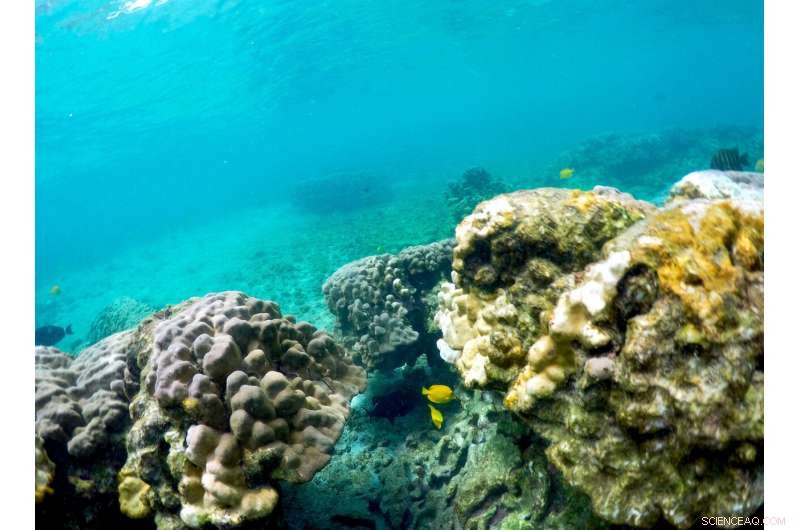
Deze 12 september Foto uit 2019 toont verblekend koraal in Kahala'u Bay in Kailua-Kona, Hawaii. Slechts vier jaar nadat een grote hittegolf op zee bijna de helft van het koraal van deze kustlijn had gedood, federale onderzoekers voorspellen dat een nieuwe ronde van heet water enkele van de ergste koraalverbleking zal veroorzaken die de regio ooit heeft gezien. (AP Foto/Caleb Jones)
Aan de rand van een oude lavastroom waar grillige zwarte rotsen de Stille Oceaan ontmoeten, kleine off-the-grid huizen kijken uit over de kalme blauwe wateren van Papa Bay op Hawaii's Big Island - geen toeristen of hotels te bekennen. Hier, een van de meest overvloedige en levendige koraalriffen van het eiland gedijt net onder het oppervlak.
Maar zelfs deze afgelegen kustlijn ver van de effecten van chemische zonnebrandcrème, voeten vertrappelen en industrieel afvalwater vertoont vroege tekenen van wat naar verwachting een catastrofaal seizoen zal zijn voor koraal in Hawaï.
Slechts vier jaar nadat een grote hittegolf op zee bijna de helft van het koraal van deze kustlijn had gedood, federale onderzoekers voorspellen dat een nieuwe ronde heet water een van de ergste koraalverblekingen zal veroorzaken die de regio ooit heeft meegemaakt.
"In 2015 we hebben temperaturen bereikt die we nog nooit op Hawaï hebben gemeten, " zei Jamison Gove, een oceanograaf bij de National Oceanic and Atmospheric Administration. "Wat echt belangrijk is - of alarmerend, waarschijnlijk toepasselijker - over dit evenement is dat we hebben gevolgd waar we waren op dit moment in 2015."
Onderzoekers die hightechapparatuur gebruiken om de riffen van Hawaï te volgen, zien vroege tekenen van verbleking in Papa Bay en elders, veroorzaakt door een hittegolf op zee die de temperaturen maandenlang naar recordhoogten heeft doen stijgen. Juni, Juli en delen van augustus beleefden allemaal de heetste oceaantemperaturen ooit gemeten rond de Hawaiiaanse eilanden. Tot nu toe in september oceanische temperaturen zijn lager dan alleen die in 2015.
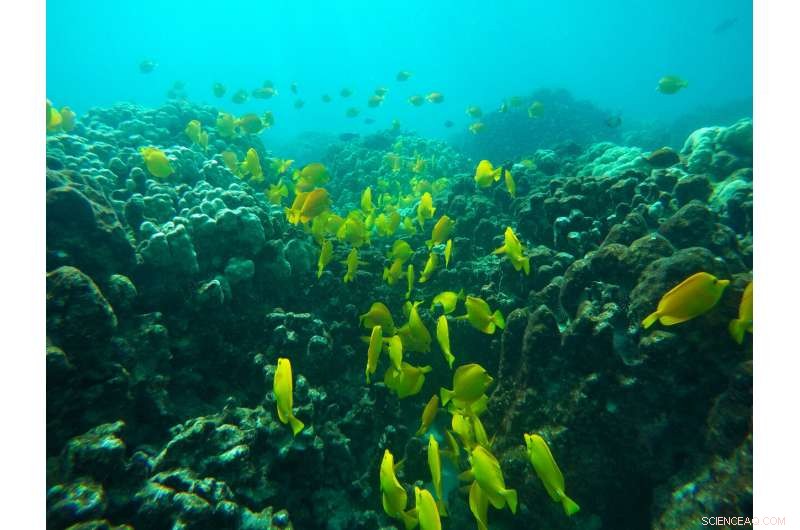
Deze 12 september De foto van 2019 toont vissen in de buurt van koraal in een baai aan de westkust van het Big Island bij Captain Cook, Hawaii. Slechts vier jaar nadat een grote hittegolf op zee bijna de helft van het koraal van deze kustlijn had gedood, federale onderzoekers voorspellen dat een nieuwe ronde van heet water enkele van de ergste koraalverbleking zal veroorzaken die de regio ooit heeft gezien. (AP Foto/Brian Skoloff)
Voorspellers verwachten dat hoge temperaturen in de noordelijke Stille Oceaan tot ver in oktober warmte in de wateren van Hawaï zullen blijven pompen.
"Temperaturen zijn al geruime tijd warm, "Zei Gove. "Het is niet alleen hoe heet het is. Het is hoe lang die oceaantemperaturen warm blijven."
Koraalriffen zijn over de hele wereld van vitaal belang omdat ze niet alleen een leefgebied vormen voor vissen - de basis van de mariene voedselketen - maar ook voor voedsel en medicijnen voor mensen. Ze vormen ook een essentiële kustlijnbarrière die grote oceaangolven breekt en dichtbevolkte kustlijnen beschermt tegen stormvloeden tijdens orkanen.
Op Hawaii, riffen zijn ook een belangrijk onderdeel van de economie:toerisme gedijt grotendeels dankzij koraalriffen die helpen bij het creëren en beschermen van iconische witte zandstranden, bieden snorkel- en duikplekken, en helpen golven te vormen die surfers van over de hele wereld aantrekken.
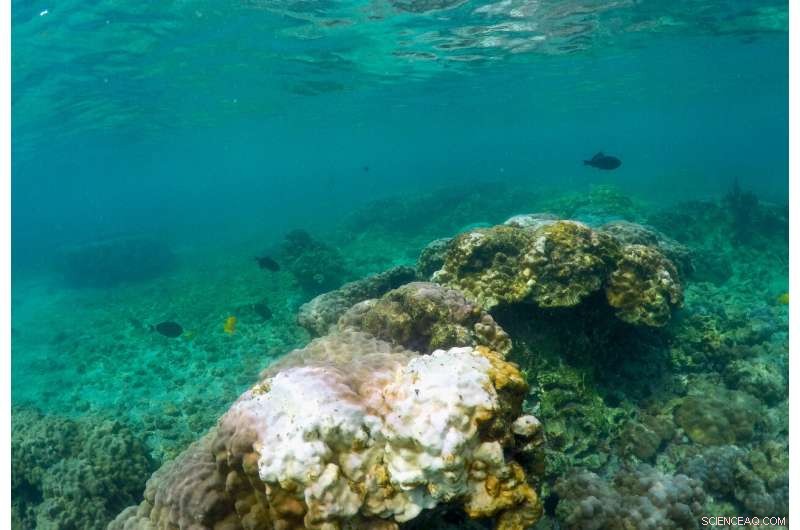
Deze 12 september Foto uit 2019 toont verblekend koraal in Kahala'u Bay in Kailua-Kona, Hawaii. Slechts vier jaar nadat een grote hittegolf op zee bijna de helft van het koraal van deze kustlijn had gedood, federale onderzoekers voorspellen dat een nieuwe ronde van heet water enkele van de ergste koraalverbleking zal veroorzaken die de regio ooit heeft gezien. (AP Foto/Caleb Jones)
De oceaantemperaturen zijn niet overal in de staat gelijkmatig warm, Gove merkte op. Lokale windpatronen, stromingen en zelfs kenmerken op het land kunnen hotspots in het water creëren.
"Je hebt dingen als twee gigantische vulkanen op het Grote Eiland die de overheersende passaatwinden blokkeren, "het maken van de westkust van het eiland, waar Papa Bay zit, een van de heetste delen van de staat, zei Gove. Hij zei dat hij op die plaatsen "ernstige" koraalverbleking verwacht.
"Dit is wijdverbreid, 100% bleken van de meeste koralen, "Zei Gove. En veel van die koralen zijn nog steeds aan het herstellen van de verbleking van 2015, wat betekent dat ze gevoeliger zijn voor thermische stress.
Volgens NOAA, De oorzaken van de hittegolf zijn onder meer een aanhoudend lagedrukweerpatroon tussen Hawaï en Alaska dat de wind heeft verzwakt die anders het oppervlaktewater in een groot deel van de noordelijke Stille Oceaan zou kunnen mengen en afkoelen. Wat de oorzaak is, is onduidelijk:het kan de gebruikelijke chaotische beweging van de atmosfeer weerspiegelen, of het kan verband houden met de opwarming van de oceanen en andere effecten van door de mens veroorzaakte klimaatverandering.
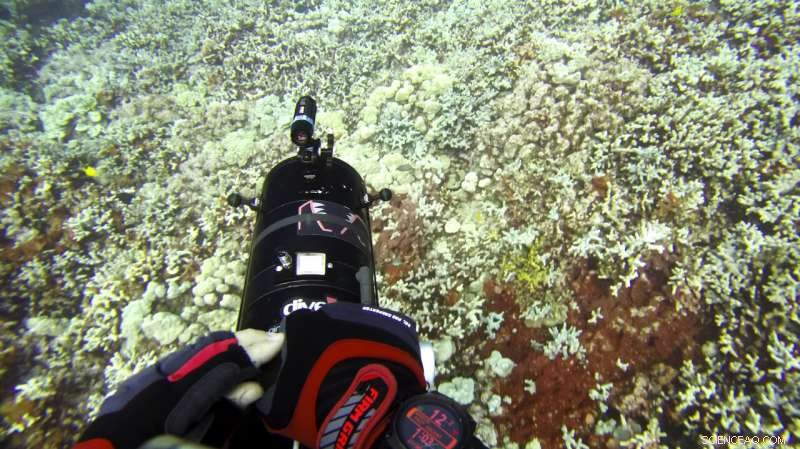
In deze 13 september, Afbeelding uit 2019 afkomstig van video geleverd door het Center for Global Discovery and Conservation Science van de Arizona State University, ecoloog Greg Asner duikt over een koraalrif in Papa Bay bij Captain Cook, Hawaii. "Bijna elke soort die we volgen heeft op zijn minst enige bleking, " zei Asner. (Greg Asner/Arizona State University's Center for Global Discovery and Conservation Science via AP)
Buiten dit evenement, oceanische temperaturen zullen de komende jaren blijven stijgen, zei Gove. "There's no question that global climate change is contributing to what we're experiencing, " hij zei.
For coral, hot water means stress, and prolonged stress kills these creatures and can leave reefs in shambles.
Bleaching occurs when stressed corals release algae that provide them with vital nutrients. That algae also gives the coral its color, so when it's expelled, the coral turns white.
Gove said researchers have a technological advantage for monitoring and gleaning insights into this year's bleaching, data that could help save reefs in the future.
"We're trying to track this event in real time via satellite, which is the first time that's ever been done, " Gove said.
In remote Papa Bay, most of the corals have recovered from the 2015 bleaching event, but scientists worry they won't fare as well this time.
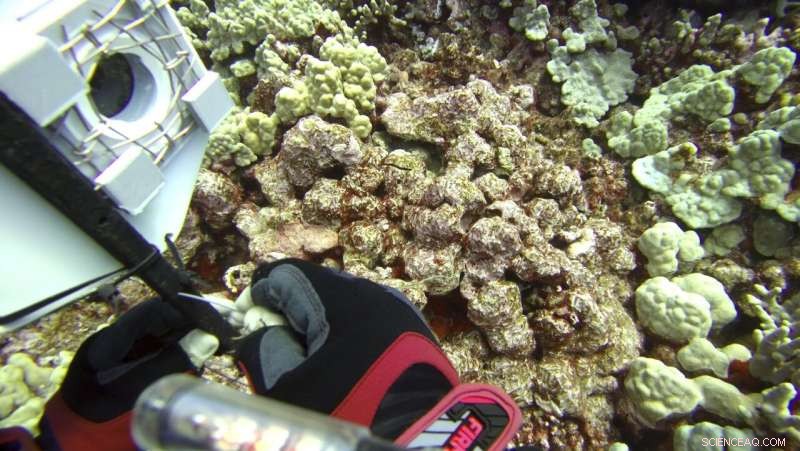
In deze 13 september, 2019, image taken from video provided by Arizona State University's Center for Global Discovery and Conservation Science, ecologist Greg Asner prepares a camera fish trap on a coral reef in Papa Bay near Captain Cook, Hawaii. "Nearly every species that we monitor has at least some bleaching, " Asner said. (Greg Asner/Arizona State University's Center for Global Discovery and Conservation Science via AP)
"Nearly every species that we monitor has at least some bleaching, " zei ecoloog Greg Asner, director of Arizona State University's Center for Global Discovery and Conservation Science, after a dive in the bay earlier this month.
Asner told The Associated Press that sensors showed the bay was about 3.5 degrees Fahrenheit above what is normal for this time of year.
He uses advanced imaging technology mounted to aircrafts, satellietgegevens, underwater sensors and information from the public to give state and federal researchers like Gove the information they need.
"What's really important here is that we're taking these (underwater) measurements, connecting them to our aircraft data and then connecting them again to the satellite data, " Asner said. "That lets us scale up to see the big picture to get the truth about what's going on here."
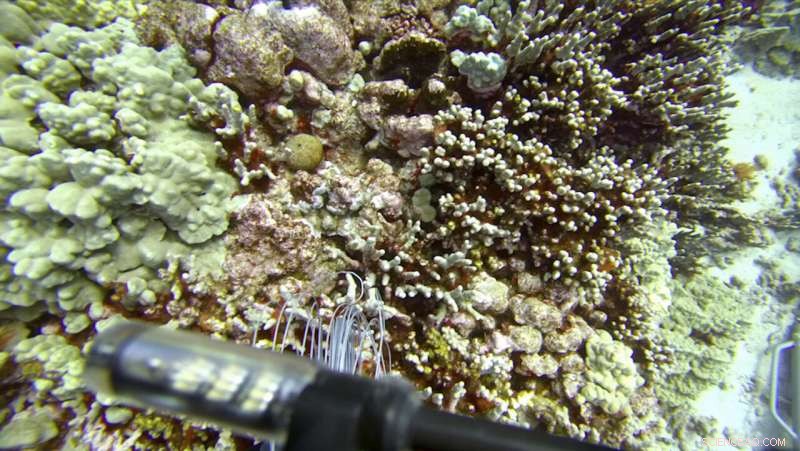
In deze 13 september, 2019 image taken from video provided by Arizona State University's Center for Global Discovery and Conservation Science, ecologist Greg Asner dives over a coral reef in Papa Bay near Captain Cook, Hawaii. "Nearly every species that we monitor has at least some bleaching, " Asner said. (Greg Asner/Arizona State University's Center for Global Discovery and Conservation Science via AP)
Scientists will use the information to research, onder andere, why some coral species are more resilient to thermal stress. Some of the latest research suggests slowly exposing coral to heat in labs can condition them to withstand hotter water in the future.
"After the heat wave ends, we will have a good map with which to plan restoration efforts, " Asner said.
In de tussentijd, Hawaii residents like Cindi Punihaole Kennedy are pitching in by volunteering to educate tourists. Punihaole Kennedy is director of the Kahalu'u Bay Education Center, a nonprofit created to help protect Kahalu'u Bay, a popular snorkeling spot near the Big Island's tourist center of Kailua-Kona.
The bay and surrounding beach park welcome more than 400, 000 visitors a year, ze zei.
"We share with them what to do and what not to do as they enter the bay, "zei ze. "Bijvoorbeeld, avoid stepping on the corals or feeding the fish."
-
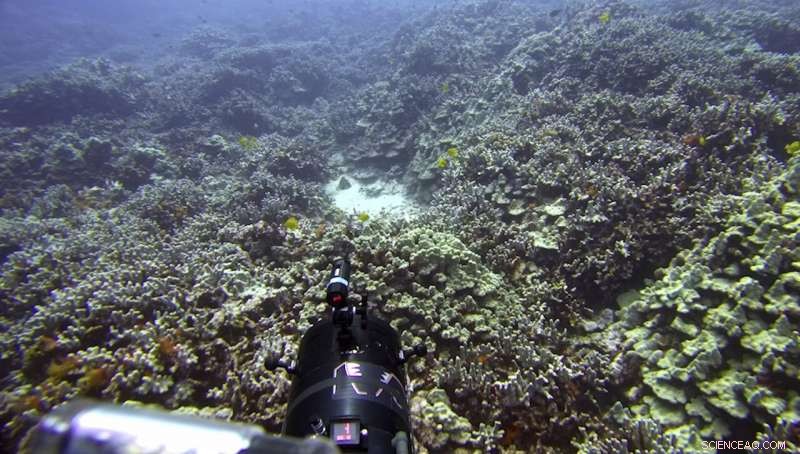
In deze 13 september, 2019 image taken from video provided by Arizona State University's Center for Global Discovery and Conservation Science, ecologist Greg Asner dives over a coral reef in Papa Bay near Captain Cook, Hawaii. "Nearly every species that we monitor has at least some bleaching, " Asner said. (Greg Asner/Arizona State University's Center for Global Discovery and Conservation Science via AP)
-
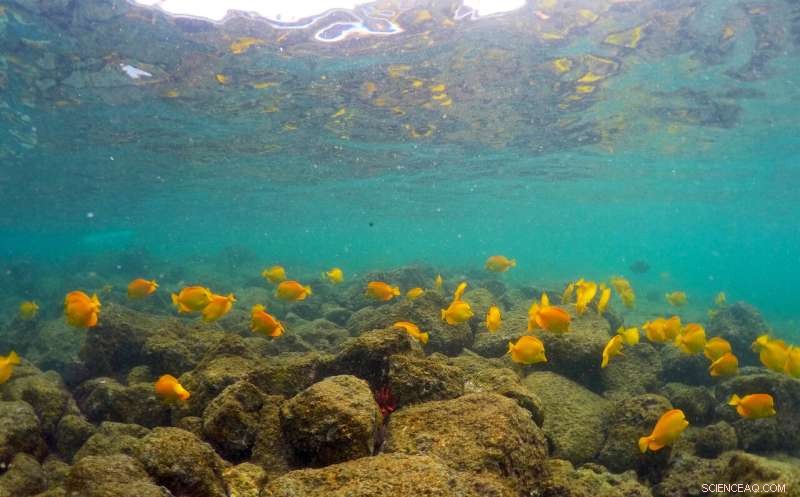
In this Sept. 12, 2019 foto, fish swim near bleaching coral in Kahala'u Bay in Kailua-Kona, Hawaii. Just four years after a major marine heat wave killed nearly half of this coastline's coral, federal researchers are predicting another round of hot water will cause some of the worst coral bleaching the region has ever seen. (AP Foto/Caleb Jones)
-
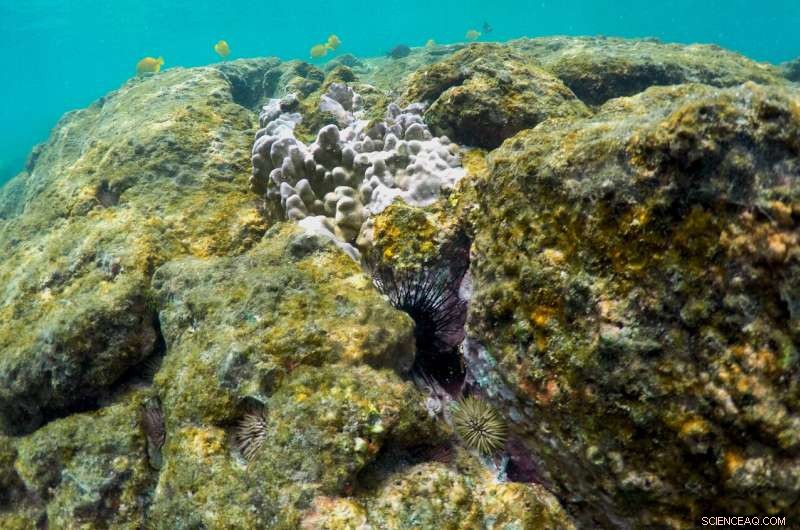
In this Sept. 12, 2019 foto, sea urchins and fish are seen near bleaching coral in Kahala'u Bay in Kailua-Kona, Hawaii. Just four years after a major marine heat wave killed nearly half of this coastline's coral, federal researchers are predicting another round of hot water will cause some of the worst coral bleaching the region has ever seen. (AP Foto/Caleb Jones)
-
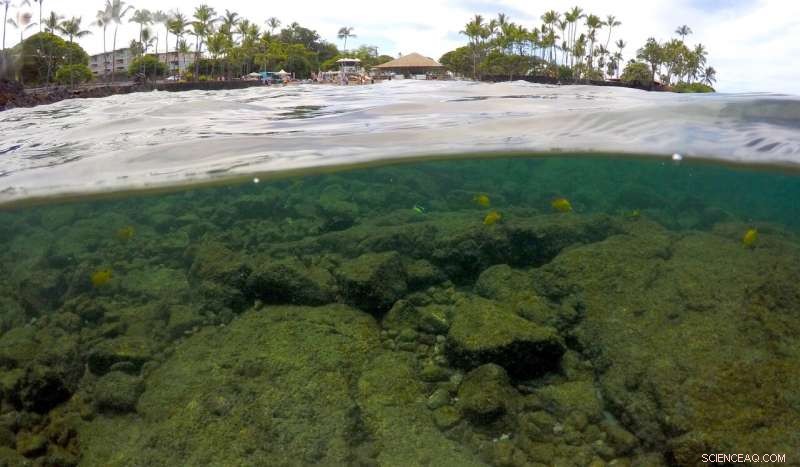
In this Sept. 12, 2019 foto, fish swim near bleaching coral in Kahala'u Bay in Kailua-Kona, Hawaii. Coral reefs are vital around the world as they not only provide a habitat for fish—the base of the marine food chain—but food and medicine for humans. They also create an essential shoreline barrier that breaks apart large ocean swells and protects densely populated shorelines from storm surges during hurricanes. (AP Foto/Caleb Jones)
-
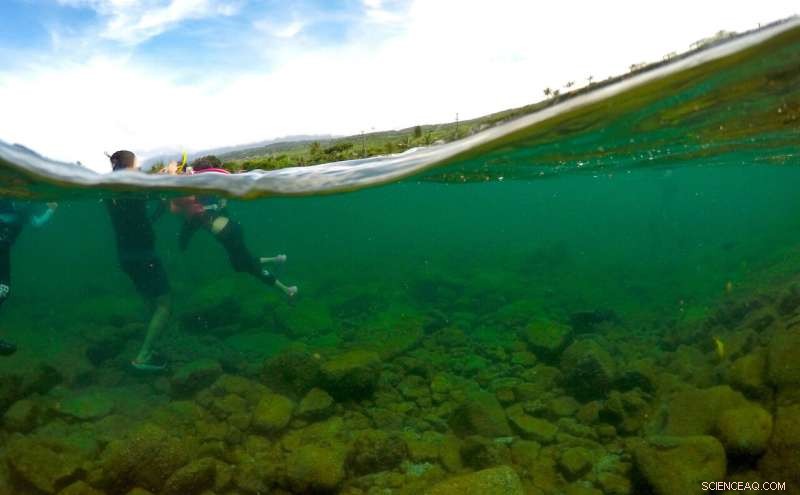
In this Sept. 12, 2019 foto, visitors stand in Kahala'u Bay in Kailua-Kona, Hawaii. Hawaii residents like Cindi Punihaole Kennedy are pitching in by volunteering to educate tourists. Punihaole Kennedy is director of the Kahalu'u Bay Education Center, a nonprofit created to help protect Kahalu'u Bay, a popular snorkeling spot near the Big Island's tourist center of Kailua-Kona. (AP Foto/Caleb Jones)
-
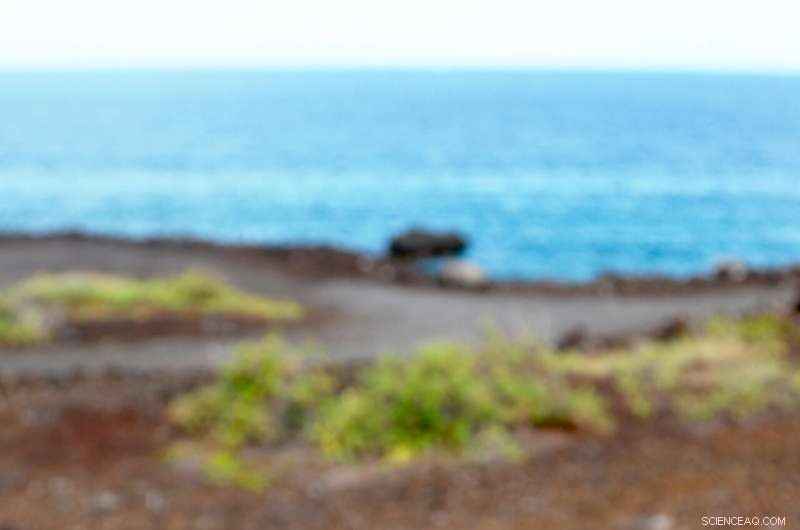
This Sept. 13, 2019 photo shows a chunk of bleached, dead coral shown on a wall near a bay on the west coast of the Big Island near Captain Cook, Hawaii. Coral reefs are vital around the world as they not only provide a habitat for fish—the base of the marine food chain—but food and medicine for humans. They also create an essential shoreline barrier that breaks apart large ocean swells and protects densely populated shorelines from storm surges during hurricanes. (AP Foto/Caleb Jones)
-
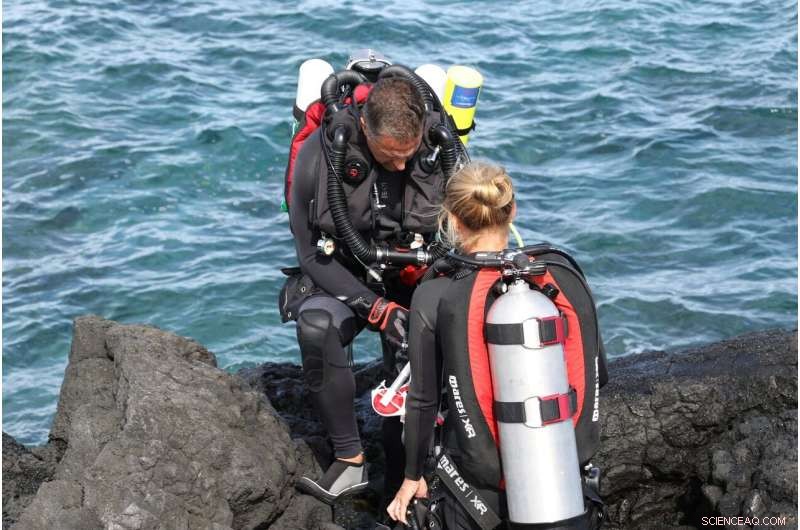
In deze 13 september, 2019 foto, researchers prepare to dive on a coral reef on the west coast of the Big Island near Captain Cook, Hawaii. One of the state's most vibrant coral reefs thrives just below the surface in a bay on the west coast of Hawaii's Big Island. Hier, on a remote shoreline far from the impacts of sunscreen and throngs of tourists, scientists see the early signs of what's expected to be a catastrophic season of coral bleaching in Hawaii. The ocean here is about three and a half degrees above normal for this time of year. Coral can recover from bleaching, but when it is exposed to heat over several years, the likelihood of survival decreases. (AP Foto/Caleb Jones)
-
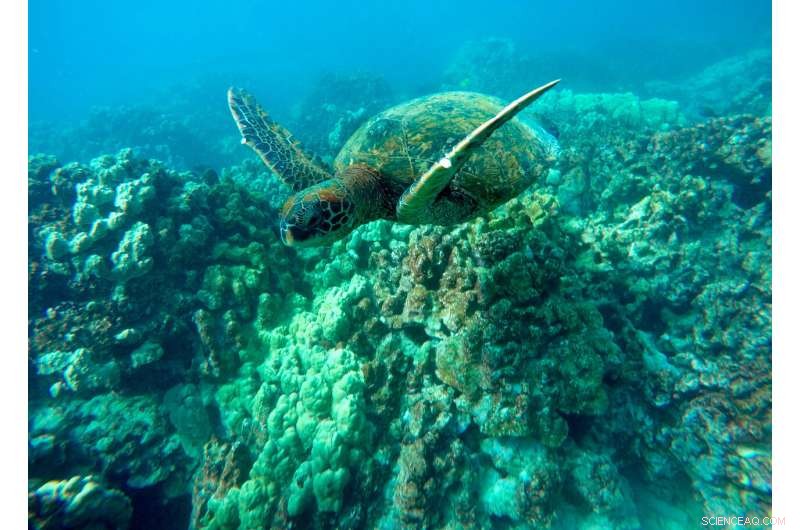
In this Sept. 11, 2019 foto, a green sea turtle swims near coral in a bay on the west coast of the Big Island near Captain Cook, Hawaii. Just four years after a major marine heat wave killed nearly half of this coastline's coral, federal researchers are predicting another round of hot water will cause some of the worst coral bleaching the region has ever seen. (AP Photo/Brian Skoloff)
-
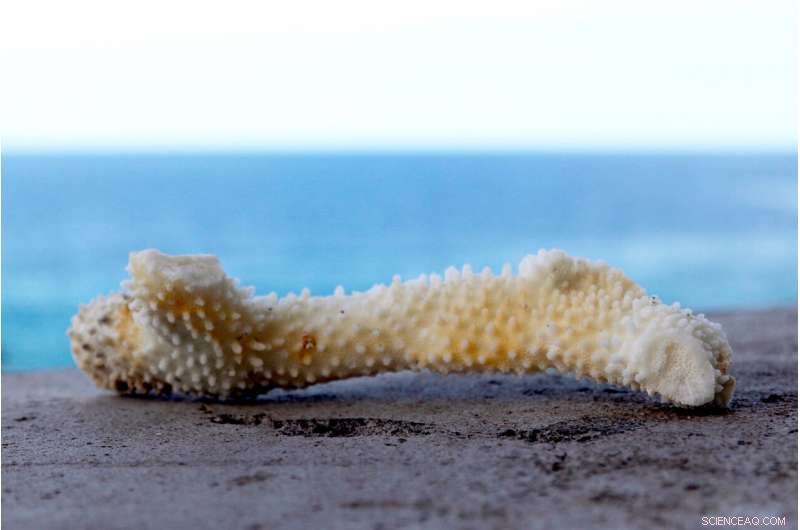
This Sept. 13, 2019 photo shows a chunk of bleached, dead coral shown on a wall near a bay on the west coast of the Big Island near Captain Cook, Hawaii. One of the state's most vibrant coral reefs thrives just below the surface in a bay on the west coast of Hawaii's Big Island. Hier, on a remote shoreline far from the impacts of sunscreen and throngs of tourists, scientists see the early signs of what's expected to be a catastrophic season of coral bleaching in Hawaii. The ocean here is about three and a half degrees above normal for this time of year. Coral can recover from bleaching, but when it is exposed to heat over several years, the likelihood of survival decreases. (AP Foto/Caleb Jones)
-
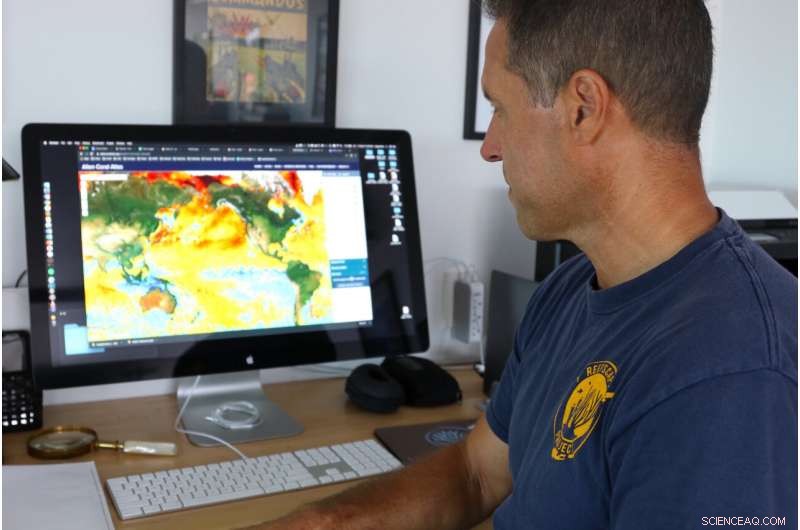
In deze 13 september, 2019 foto, ecologist Greg Asner, the director of Arizona State University's Center for Global Discovery and Conservation Science, reviews ocean temperature data at his lab on the west coast of the Big Island near Captain Cook, Hawaii. "Nearly every species that we monitor has at least some bleaching, " said Asner after a dive in Papa Bay. (AP Photo/Caleb Jones)
-
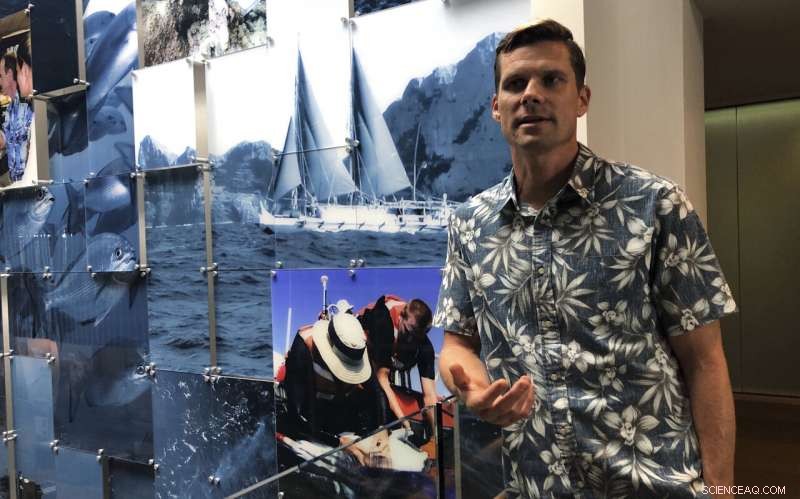
In this Sept. 16, 2019 foto, National Oceanic and Atmospheric Administration oceanographer Jamison Gove talks about coral bleaching at the NOAA regional office in Honolulu. U.S. federal researchers in Hawaii say ocean temperatures around the archipelago are on track to match or even surpass records set in 2015, the hottest year on record for the Pacific Ocean. They predict that heat will cause some of the worst coral bleaching and mortality the region has ever seen. (AP Foto/Caleb Jones)
-
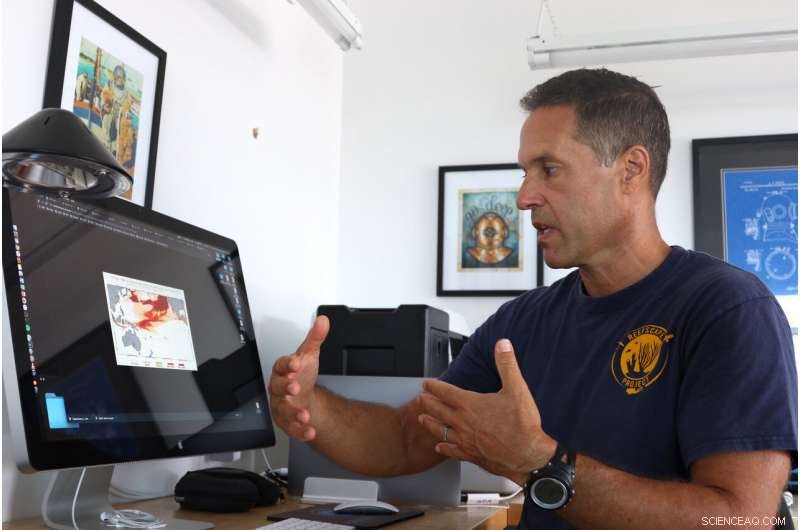
In deze 13 september, 2019 foto, ecologist Greg Asner, the director of Arizona State University's Center for Global Discovery and Conservation Science, reviews ocean temperature data at his lab on the west coast of the Big Island near Captain Cook, Hawaii. "Nearly every species that we monitor has at least some bleaching, " said Asner after a dive in Papa Bay. (AP Photo/Caleb Jones)
The bay suffered widespread bleaching and coral death in 2015.
"It was devastating for us to not be able to do anything, " Punihaole Kennedy said. "We just watched the corals die."
© 2019 The Associated Press. Alle rechten voorbehouden.
 Hoe Polariteit te berekenen
Hoe Polariteit te berekenen  Moeten onderwijs en communicatie over de vooruitgang van microfluïdica worden verbeterd?
Moeten onderwijs en communicatie over de vooruitgang van microfluïdica worden verbeterd? Nieuwe lijm plakt gemakkelijk, houdt goed, en is een gas om uit elkaar te trekken
Nieuwe lijm plakt gemakkelijk, houdt goed, en is een gas om uit elkaar te trekken Hoe beïnvloedt temperatuur de Catalase enzymactiviteit?
Hoe beïnvloedt temperatuur de Catalase enzymactiviteit?  Alles samenvoegen:inspiratie voor taaie en zelfherstellende materialen
Alles samenvoegen:inspiratie voor taaie en zelfherstellende materialen
Hoofdlijnen
- Chimpstudie onthult hoe de hersenstructuur onze evolutie heeft gevormd
- Slapen of niet:onderzoekers onderzoeken complex genetisch netwerk achter slaapduur
- Terugkeer van de inheemse wilde kalkoen - duurzame oogstdoelen stellen wanneer de informatie beperkt is
- Canadese kariboes, habitat blijft afnemen:rapport
- Organellen gevonden in beide planten- en bacteriecellen
- Wat zijn de twee belangrijkste functies van nucleïnezuur in levende wezens?
Nucleïnezuren zijn kleine stukjes materie met grote rollen om te spelen. Genoemd naar hun locatie - de kern - deze zuren dragen informatie die cellen helpt bij het maken va
- Voors en tegens van Recombinant DNA Technology
- Wat doet acetonalcohol met een gramkleuring?
- Luie mieren maken zichzelf op onverwachte manieren nuttig
- Mexico's energiehervorming kan sociaal-milieuconflicten vergroten

- NASA-NOAA-satelliet analyseert regenmaker orkaan Florence
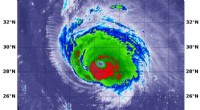
- Stranden die gevaar lopen door de toename van koolstofdioxide in de lucht
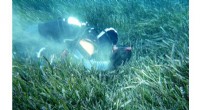
- De aarde zonk tweemaal, overstroming van de oostelijke Amazone:team vindt haaientand in noordwestelijk Amazonebekken
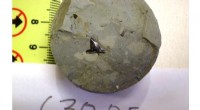
- Studie onthult dreiging van catastrofale supervulkaanuitbarstingen die altijd aanwezig zijn

 Eerste directe datering van Homo antecessor
Eerste directe datering van Homo antecessor Dark Energy Survey detecteert duizenden sterrenstelsels met een lage oppervlaktehelderheid
Dark Energy Survey detecteert duizenden sterrenstelsels met een lage oppervlaktehelderheid Een nieuwe manier om koeling te bieden zonder stroom
Een nieuwe manier om koeling te bieden zonder stroom Gemodificeerde optische centrifuge heeft potentieel om nieuwe manieren te openen voor de studie van superrotors
Gemodificeerde optische centrifuge heeft potentieel om nieuwe manieren te openen voor de studie van superrotors Juli 2019 warmste maand ooit voor planeet:NOAA
Juli 2019 warmste maand ooit voor planeet:NOAA Nieuwe multispectrale gebogen samengestelde oogcamera ontwikkeld met ultragroot gezichtsveld
Nieuwe multispectrale gebogen samengestelde oogcamera ontwikkeld met ultragroot gezichtsveld De verdwijning van vrouwelijke onderzoekers in tijden van pandemie
De verdwijning van vrouwelijke onderzoekers in tijden van pandemie Verborgen symmetrie kan de sleutel zijn tot robuustere kwantumsystemen, onderzoekers vinden
Verborgen symmetrie kan de sleutel zijn tot robuustere kwantumsystemen, onderzoekers vinden
- Elektronica
- Biologie
- Zonsverduistering
- Wiskunde
- French | Italian | Spanish | Portuguese | Swedish | German | Dutch | Danish | Norway |

-
Wetenschap © https://nl.scienceaq.com

